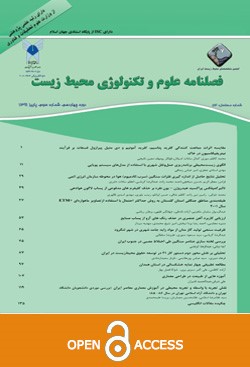ارزیابی اثربخشی سناریوهای جایگزینی ناوگان اتوبوس، در کاهش آلودگی هوای شهر کرج
محورهای موضوعی : آلودگی هوا
نیکی آقاپور
1
,
مظاهر معین الدینی
2
*
![]()
1 - کارشناس ارشد علوم و مهندسی محیط زیست- آلودگیها، گروه محیطزیست، دانشکده منابع طبیعی، دانشگاه تهران.
2 - دکتری محیطزیست، دانشیار گروه محیط زیست، دانشکده منابع طبیعی، دانشگاه تهران. * (مسوول مکاتبات)
کلید واژه: مدلIVE, آلودگی هوا, کرج, جایگزینی ناوگان فرسوده,
چکیده مقاله :
زمینه و هدف: با توجه به ناوگان حملونقل عمومی فرسوده در شهر کرج، نیاز به جایگزینی ناوگان با استانداردهای بهروز دارد. با توجه به ابعاد اقتصادی و محیطزیستی بایستی اثربخشی اقدامات انجام شده مورد سنجش قرار گیرد. بنابراین دستیابی به هدف ارزیابی تغییر در انتشار آلایندهها براساس هر سناریوی جایگزینی، میتواند به مسئولان در جهت اتخاذ استراتژیهای کاهش آلودگی هوا کمک نماید. هدف طراحی سناریوها، در این پژوهش، برآورد میزان موثر بودن سناریوها در حوزه جایگزینی ناوگان اتوبوسهای واحد فرسوده، در کاهش انتشار آلایندههای، هوا است. روش بررسی: ابتدا دستهبندی اتوبوسواحد براساس پارامترهایی از جمله سیستمهای مختلف، سال تولید، استاندارد آلایندگی، نوع سوخت مصرفی و کلاس خودرو در سال 9813 مورد بررسی قرار گرفتهاند. در ادامه به طراحی سناریوهای کاهش آلایندههای معیار در دو طرح، جایگزینی ناوگان فرسوده به ناوگان هیبریدی، دوگانهسوز و با سوخت مصرفی، دارای استاندارد آلایندگی یورو 4، پرداختهشد و در نهایت سناریوها، با سناریو پایه مقایسه شد. ضرایب انتشار آلایندگی و طراحی سناریوها با استفاده از مدل بین المللی انتشار وسایلنقلیه متحرک (IVE)، به ازای معابر، شریانی درجه 1، بزرگراهی و آزادراهی، با شیبهای صفر و 2 ± درصد محاسبه شدند. یافتهها: نتایج مقایسه سناریوها نشان داد، با جایگزینی کل ناوگان فرسوده از نظر سن (به ناوگان جدید، سناریوی چهارم)، بیشترین کاهش انتشار آلایندههای معیار، 40 % (CO)، 60% (VOC)، 42% (NOX)، 86% (PM)، را نشان داد. همچنین نتایج توزیع انتشار آلایندهها در شهر کرج، با نرمافزار Arc Map نشان داد که بیشترین انتشار آلایندهها، مربوط به منطقه 10، و کمترین انتشار، منطقه 1، شهر کرج است. بحث و نتیجهگیری: بر اساس یافتهها میزان اثربخشی سناریوهای جایگزینی ناوگان فرسوده (استفاده از خودروهای هیبریدی، دوگانهسوز و با سوخت یورو 4)، در کاهش انتشار آلایندههای هوا، 40 تا 80 درصد بودهاست. سناریوهای کاهش انتشار آلایندهها و راهکارهای افزایش کیفیت هوا برای سیاستمداران و محققان برای فهم بهتر شرایط جاری آلودگی هوا در منطقه مفید و تا حد زیاد عملیاتی است، که نیاز به تأمین بهموقع بودجه و برنامهریزی مدون و دقیق برای اجرا دارند.
Background and Objective: Considering the worn-out public transport fleet in Karaj city, it needs to replace the fleet with up-to-date standards. Considering the economic and environmental dimensions, the effectiveness of the measures taken should be evaluated. Therefore, achieving the goal of evaluating the change in the emission of pollutants based on each alternative scenario can help the authorities to adopt air pollution reduction strategies. The purpose of designing scenarios in this research is to estimate the effectiveness of scenarios in the field of replacing the fleet of worn-out single buses in reducing the emission of air pollutants. Material and Methodology: First, the classification of buses and units based on parameters such as different systems, year of production, pollution standard, type of fuel consumed and vehicle class have been studied at 1398. Then, scenarios of reducing standard pollutants were designed in two plans, replacing the worn-out fleet with a hybrid fleet, dual-fuel and with fuel consumption, with Euro 4 pollution standard, and finally the scenarios were compared with the basic scenario. Pollution emission coefficients and scenario design were calculated using the International Model of Mobile Vehicle Emission (IVE) model for passages, 1st degree arteries, highways and freeways, with slopes of zero and 22%. Findings: The results of comparing the scenarios showed that by replacing the entire worn-out fleet in terms of age (to the new fleet, scenario four), the maximum reduction in emissions of standard pollutants was 40% (CO, 60% (VOC), 42% (NOX), 86% (Also, the results of the distribution of pollutants in the city of Karaj, with Arc Map software showed that the highest emission of pollutants is related to region 10, and the lowest emission is in region 1, Karaj city. Discussion and Conclusion: According to the findings, the effectiveness of replacement scenarios of the worn-out fleet (use of hybrid, dual-fuel vehicles with Euro 4 fuel) in reducing the emission of air pollutants has been 40 to 80%. Pollutant reduction scenarios and strategies to increase air quality are useful for policymakers and researchers to better understand the current state of air pollution in the region and are largely operational, requiring timely funding and well-planned planning.
_||_

